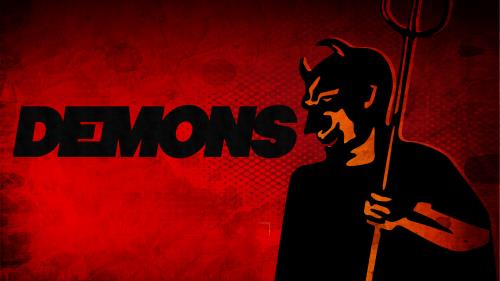-
Doctrines & Demons
Contributed by Matthew Kratz on Oct 27, 2023 (message contributor)
Summary: 1) The Predictability of Apostasy (1 Timothy 4:1), 2) The Purveyors of Apostasy (1 Timothy 4:2), 3) The Principles of Apostasy (1 Timothy 4:3a), and know: 4) The Response to Apostasy (1 Timothy 4:3b–5)
1 Timothy 4:1-5. [4:1] Now the Spirit expressly says that in later times some will depart from the faith by devoting themselves to deceitful spirits and teachings of demons, [2] through the insincerity of liars whose consciences are seared, [3] who forbid marriage and require abstinence from foods that God created to be received with thanksgiving by those who believe and know the truth. [4] For everything created by God is good, and nothing is to be rejected if it is received with thanksgiving, [5] for it is made holy by the word of God and prayer. (ESV)
Halloween invokes images of costumes, trick-or-treating, scary movies, creepy decorations, and similar festive décor. Many have wondered if the last day of October, especially during the evening, is a time of immense criminal activity. " Gwendolyn Crump, director of the Office of Communications for the Metropolitan Police Department of Washington, D.C. contrasted crime rates from one particular Halloween to the next..Crump noted that between those two dates, violent crime was down 26 percent, property crime was down 11 percent, and overall crime was down 15 percent. He noted, with all the activity of masked individuals, many communities have their own neighborhood watches during Halloween, which may factor into there being a lower and possibly decreasing crime rate. (http://www.christianpost.com/news/does-the-crime-rate-spike-on-halloween-107814/#vRvs4rjy2d3Qc7cL.99)
In Ephesus, false teachers hid their true intentions, and the local congregations were called on to carefully watch for their activities (Eph. 1:3–7, 18–20). In chapters 2 and 3, Paul dealt with some of the ramifications of their false teaching and corruption of the church. He countered their deceptions with the divine design for men and women in the church. Chapter 3 closed with a creedal statement affirming what apostates most directly deny and what is the central truth of the Christian faith: the Person and work of Jesus Christ. In chapter 4, Paul returns to his discussion of the false teachers themselves. The battle lines are thus sharply drawn. While not always popular in our day of misunderstanding the concepts of toleration and “love,” there is a biblical mandate to deal directly and firmly with false teaching. Any tolerance of error regarding God’s revelation is a direct form of dishonor to Him (Ps. 138:2).
Since creation, the earth has been the battleground between God and Satan. God calls humanity to respond to His Word, and Satan tries to lure them to follow lies. Some claim satanic perversions to be the truth from God. Sadly, even some who profess to follow God’s truth turn away from it. It is fallen angels, those demonic beings, who energize all false religion. Like their evil master, Satan, their deception is effective because they disguise themselves as angels of light (2 Cor. 11:14).
In order to recognize and counter the false doctrines of the demonic, believers must anticipate and be ready to counter: 1) The Predictability of Apostasy (1 Timothy 4:1), 2) The Purveyors of Apostasy (1 Timothy 4:2), 3) The Principles of Apostasy (1 Timothy 4:3a), and know: 4) The Response to Apostasy (1 Timothy 4:3b–5)
In order to recognize and counter the false doctrines of the demonic, believers must anticipate and be ready to counter:
1) The Predictability of Apostasy (1 Timothy 4:1)
1 Timothy 4:1. [4:1] Now the Spirit expressly says that in later times some will depart from the faith by devoting themselves to deceitful spirits and teachings of demons, (ESV)
Before defining apostasy, Paul sets the stage of events. Although, apostasy should sadden and outrage believers, it should neither shock nor surprise them, because the Spirit explicitly says that it will occur. (cf. Matt. 24:4–12; 2 Thess. 2:3–12; 2 Peter 3:3; Jude 18; 1 John 2:18; 4:1–6; Heb. 3:12; cf 5:11–6:8; 10:26–31). Christ Himself had predicted that “many false prophets shall arise, and shall deceive many. And because iniquity shall abound, the love of many shall wax cold” (Mt. 24:11, 12). The Holy Spirit had confirmed that message to the early prophets and apostles (Outlaw, W. S. (1990). Commentary on the Books of 1 Timothy, 2 Timothy & Titus. In R. E. Picirilli (Ed.), 1 Thessalonians through Philemon (First Edition, pp. 234–235). Randall House Publications.).
Paul defines the time frame in which apostasy will take place as the later times. The later times include, but are not limited to, the eschatological future. The first coming of Christ ushered in the later or last times, which was the Messianic era. First John 2:18 supports this fact when it says simply, “Children, it is the last hour.” First Peter 1:20 states that Christ “has appeared in these last times for the sake of you.” The writer of Hebrews informs us that God “in these last days has spoken to us in His Son” (Heb. 1:2), and “now once at the consummation of the ages [Christ] has been manifested to put away sin by the sacrifice of Himself” (Heb. 9:26). From the first coming of our Lord to His return, through all this age of the church, apostasy will occur and escalate toward the end when “most people’s love will grow cold” (Matt. 24:12). What is predicted of the future is conceived of as already operative in the present, so the words have a specific contemporary significance (Guthrie, D. (1990). Pastoral Epistles: An Introduction and Commentary (Vol. 14, p. 106). Downers Grove, IL: InterVarsity Press.).

 Sermon Central
Sermon Central



